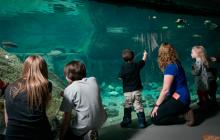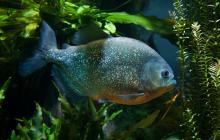Enjoy being surrounded by flowers and greenery, and feeling closer to nature? The Biodiversity Garden encourages you to plant a variety of flora, to integrate species that are native to Québec, and to adopt environmentally friendly gardening practices. That’s how you’ll attract a wide range of fauna that are useful to your garden.
What are the criteria for getting Biodiversity Garden certification?
If it meets the three criteria listed below, your Biodiversity Garden is eligible for certification.
- Presents a diversity of plants – trees, shrubs, conifers, perennials and annuals, depending on available space – to meet the needs of a variety of living organisms.
- Is composed of plants producing flowers or fruit that attract and feed pollinators, birds and/or small mammals throughout the entire season.
- Is maintained in way that respects biodiversity. To understand what this type of gardening involves: How to plant an ecologically responsible garden.
How to make a Biodiversity Garden?
There’s nothing simpler than making a Biodiversity Garden: you just have to choose a few indigenous plants, plant them in the right place, and apply a few ecological-gardening principles. Ready? Just follow these few steps:
Step 1 – Garden “with” nature
Gardening “with” nature is exciting and gratifying. And if you work with existing conditions, rather than struggling against them, everything gets easier.
Before choosing your plants and their locations, take the time to analyze the characteristics of your site. An example? Observe the sunniest areas: nectar-producing plants placed in full sunlight have a better chance of attracting pollinators.
Here are some questions to ask yourself in sketching a portrait of your site:
- How big is the area that I’d like to set up?
- What direction does my garden face?
- How many hours of sunshine does my garden enjoy?
- Which elements (fence, mature tree, neighboring building) risk creating shade?
- What are the characteristics of the soil texture, structure, organic matter content, potential of hydrogen (pH)?
- What hardiness zone is my garden located in? Find out the one for your area so that you can choose appropriate plants.
- Are there spots where water accumulates on my land? Dry areas? Be sure to identify these areas and place plants that are adapted to them.
- Does my garden receive visitors (birds, pollinators) whose presence I could encourage through the right choice of plants?
- Do you see much green nearby? If you’re the pioneers in the immediate area, be patient: wildlife will eventually locate this new oasis of greenery.
- How big will the chosen plants be when they reach maturity?
Portrait in hand, and an alliance successfully forged with your small patch of land, now you’re ready to do some looking and select the plants that will be happiest in your little corner of paradise!
Step 2 – Cultivating biodiversity
Creating a garden means giving birth to a small world filled with life, reproducing on a small scale the richness of natural ecosystems. It can feed, shelter and facilitate the breeding of useful insects, birds and other small animals. It is a good way to support part of the food chain around your home.
Plants for feeding
Choose varied nectar-producing plants offering successive flowerings. Whether they’re perennials or annuals, they’ll cook up an all-you-can-eat “floral buffet” that will be prized by pollinators throughout the season.
Plants for lodging
Provide a host of possible “accommodations” by varying the height of plants. Depending on available space, mix grasses with shrubs, leafy trees with conifers. If they produce seeds and fruit, they’ll be doing double duty: pantry and housing!
If space, time spent in the garden and your energy permit, reduce the grassy area and increase the surface area of flowerbeds. Also consider leaving some plant debris on site to serve as building materials or shelter for many visitors.
Plants for welcoming
Like good partners, native plants attract and support native wildlife. If they are adapted to the conditions of your garden, don’t hesitate to select them. Many native species are produced and available at nurseries. Be informed and avoid removing them from their natural environments.
With a little luck and a lot of patience, some useful insects, birds or other small animals will find ideal conditions for breeding in your garden. You could be witness to life renewing itself all around you!
Browse through these lists of recommended plants:
Finally, be curious and get information when making your choice of plants. Make sure not to introduce invasive exotic species.
Step 3 – Tending the garden in an ecologically sound way
For making an environmentally friendly garden, follow the basic principles of organic gardening.
Did you know that …
You need show tolerance and patience to attract biodiversity into your garden. Plants and animals don’t just move instantly.
Also, the presence of these new guests may not fit your notion of the ideal garden. The leaves of your plants risk being nibbled on by caterpillars – but you will eventually get to observe the butterflies. Bees and other pollinators will forage your flowers. Birds will dig into your flowerbeds for worms and insects. Don’t look at these intrusions negatively; rather, consider them a sign that you’ve done your work and your garden is becoming a space for life!






